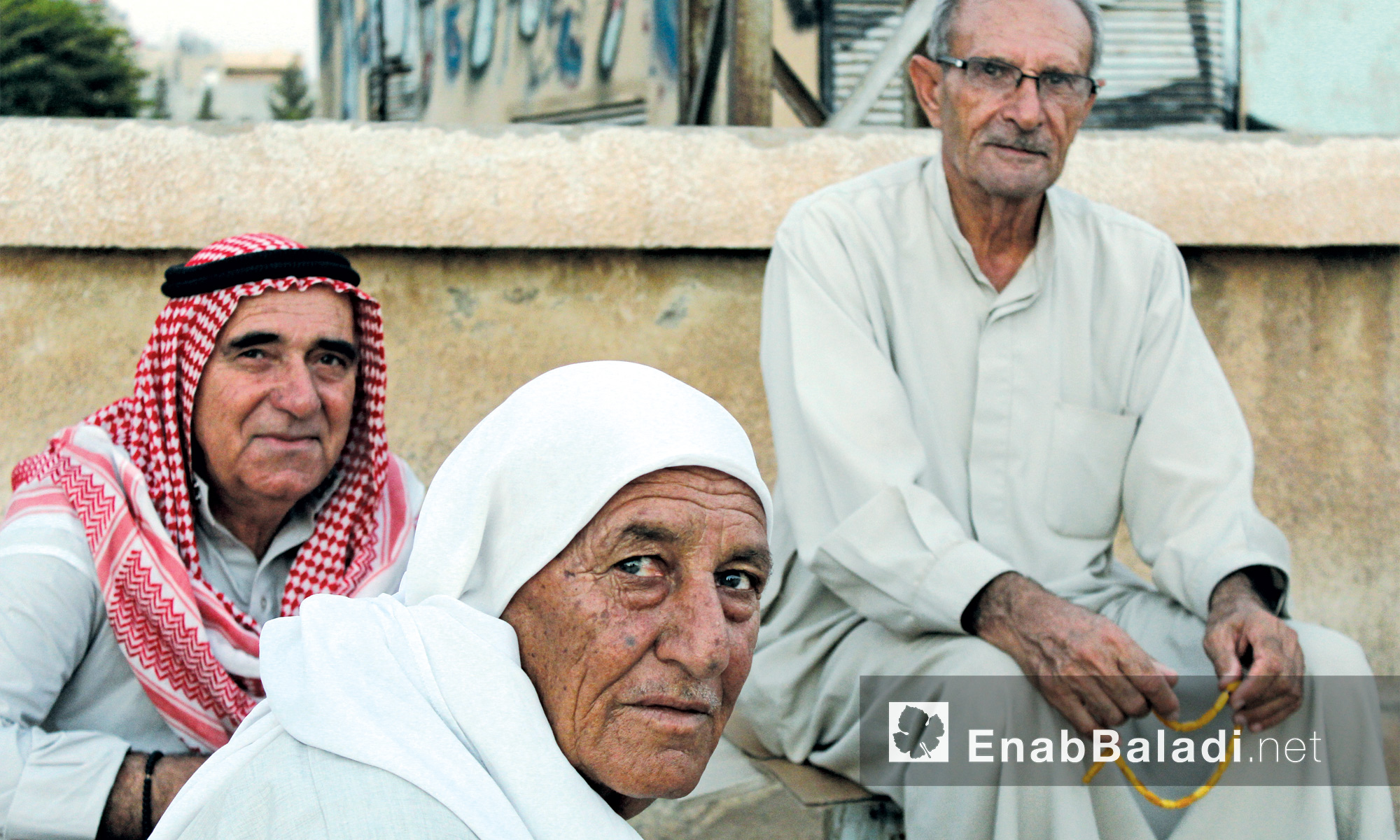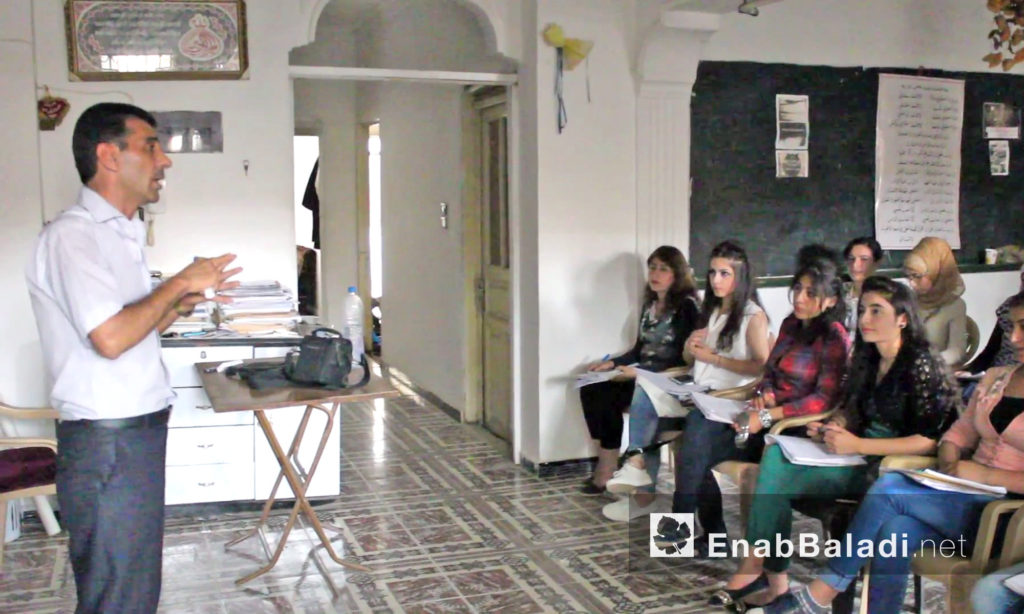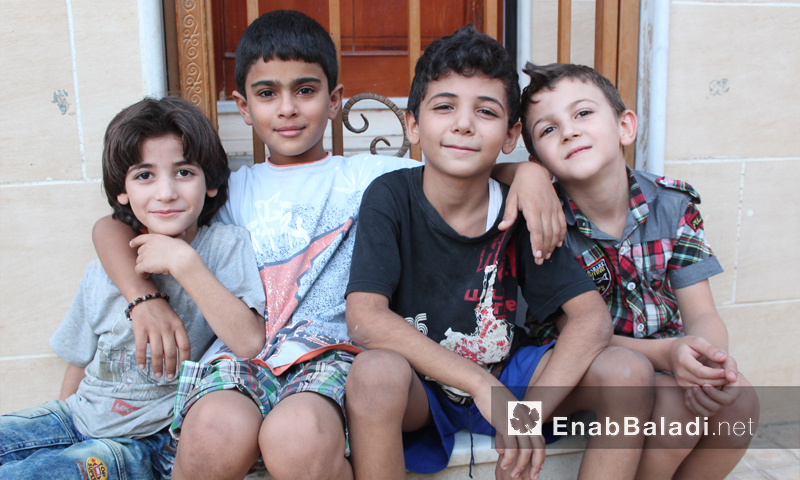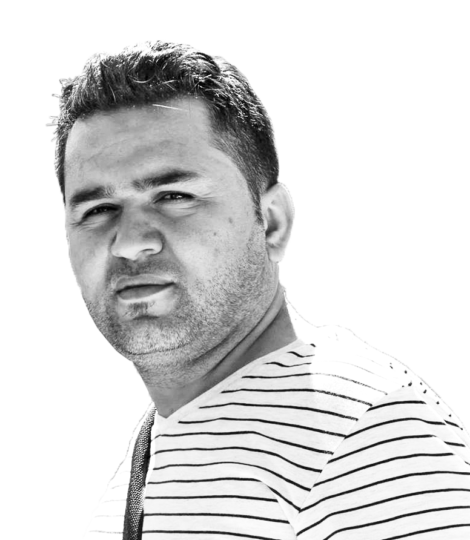The Syrian Jazeera represents an image of the rich cultural diversity of Syria, making this small spot in the far northeast corner of the country quite a colorful mosaic. It expresses itself using many synonyms for a single word, and the people of the area mix in a way that blends together even the harshest colors.
Ideally, the region would have naturally established an organized method to handle all the social interactions that take place daily by virtue of so much close-packed diversity. Having a single regional language would allow children to study at the same schools, and learn later on at the same universities, without a need to separate or translate the differences between them, an act that by definition deepens the difference.
Instead, each different ethnicity carried along their languages and habits, and maintained their own heritage, poetry and literature. The land that was expressed in different metaphors has in turn imposed a general metaphor that made all the spoken languages in Jazeera comprehended, even minimally, by all the different ethnicities.
The Syrian Jazeera produced a group of writers and poets who benefited from the cultural abundance in the region, as well as the linguistic diversity that collected their stock of images, metaphors, and ideas.
Because Kurds and Arabs were the major components of the Syrian Jazeera, Arabic and Kurdish were the most widely spread languages. However, Arabic became the language of instruction at schools, associated with the Syrian identity, and therefore was the language understood by the majority and the most used medium among the community members including traders, customers, neighbors, relatives, media, and married couples.
Arabic was additionally the most influential in general culture, as the majority of the residents in northeast Syria are Muslims. Arabic is the language of the Quran, and is the language used in Masjids, where Muslims perform their prayers and listen to Friday sermons without giving attention to the different ethnicities of their fellow worshippers.
The Kurdish language was a medium in many cases, especially for Arabs living in majority-Kurd neighborhoods. Even with limited knowledge of the language, it was enough to allow intermingling and communication between neighbors. It is worth mentioning that the Assad regime pursued many avenues to limit the spread of the Kurdish language and prevent its use on a wide scale.
Window shops in the cities of Hasaka, Qamishli, Malkieh and Amuda provide a perfect example of this intermingling, with shop owners writing their store names and logos in two or three languages, arranged according to the majority of the area. You will never see a banner written in one language only.
Loyalty to knowledge…
Echoes of the rules of the Arabic grammar inside the classrooms of Qamishli
Teacher Khaled begins his morning and ends it at its regular time, not affected by war, and engages in a routine that is renewed each year with the new faces of the students and their different dialects. Economic obstacles, as well as the security tension in the city of Qamishli, north-eastern Syria, were not strong enough to take away the teacher’s sneaky sense of fun, coming from those short breaks between classes.
In his small office where he teaches Arabic, teacher Khaled Najeeb flips through a reference book to verify some information he discussed earlier with one of his students. He insists on teaching them more than what the school curriculum covers, hoping to increase the fun and interest during later sessions.
“I use an entertaining method to deal with the students, trying to deliver ideas with ease and flexibility,” says Khaled, of a Kurdish family, to Enab Baladi, adding “it sounds exhausting, especially since my students are Kurds. That is why I often have to start from scratch in regards to the rules of the language.”
However, the efforts are a prize for the students, who “nowadays suffer harsh circumstances of war, poverty and high costs of living.” Khaled adds that “we are trying to give them some hope to finish their study, as well as grant them moral support to face all different kinds of harsh circumstances and to complete their education, which means a promise of a better Syria.”
As a result of a war that has hampered the lives Syrians everywhere and forced millions to flee, the reality seemed to be that education as a practice in Syria was at risk. Students’ were dropping out schools and turning to work because of poor financial situations and other dire conditions caused by unreliable electricity, rising prices, declining numbers of teachers, and damaged school buildings.
Khaled believes that the demand for education in the Syrian Jazeera area was at its peak ten years ago, when high morale and the desire to prosper were strong motivation across ethnicities to support education at all levels.
The teacher’s attempt to root the “passion for knowledge” in the hearts of the students springs from his relationship with his own children. At home, he tries to blend the knowledge he gained studying Arabic Literature at the University of Damascus, with a more personal connection to the Kurdish language as a means of maintaining their cultural Kurdish identity. “I am used to speaking Kurdish to my family,” he says, “yet, we all learn Arabic at schools and care about it, since it is the language of the Holy Quran.”
Teacher Khaled comes from and lives in the city of Qamishli. This city’s borders encompass several hundred Arab villages mixed with roughly 185 Kurdish villages and several more Assyrian and mixed-ethnicity villages. The result is a distinctive state of cultural diversity that can be seen through the different languages residents use to communicate.
Journalist Ahmad Shawish believes that language “undertakes the role of maintaining the entity of the group, and the difference from other entities grants it a distinctive presence or richness of nations, tribes and ethnicities.” In an interview with Enab Baladi, he added that language as a means of communication, understanding and coexisting cannot be limited to an individual or group.
While teacher Khaled walks us around to show us the place he uses to teach students in his office, he stresses that his relation to the Arabic language stems from passion he felt since childhood, which prompted him to pursue Arabic Literature. However, he believes that using a Kurdish curriculum in his classes does not contradict his relationship with Arabic, considering that “it is one of the rights of any people to study in their mother tongue.”
Farid Sadoun, Dean of the Faculty of Arts in Hasaka, affiliated with the University of Euphrates, believes in the responsibility of the Syrian regime in oppressing the Kurdish language. Despite the fact that Kurds continued to use their language widely at homes and on the streets, however, the regime insisted on giving it no value for a very long time.
Sadoun adds that language in the Syrian Jazeera was never a reason to disrupt the coexistence among the cultures, however, the regime deliberately created a “linguistic strife” by subordinating Kurdish to spark a reaction among those who spoke it.
The Self-Management in the northeast of the country has recently decided to include Kurdish curricula in the first elementary classes, in addition to the basic Arabic curricula. The administration at the University of Rojava also established a section for “Kurdish Literature,” which is the first of its kind in Syria, scheduled to be launched next year in the city of Qamishli.
However, he says, ”the hasty entry of the Kurdish language into education, and converting all materials from Arabic might produce a negative impact, since we are short of specialized staff to conduct this matter.”
He adds that the lack of specialists in the area affects education in general. The large numbers of migrants fleeing the war created a void in the education sector, and Sadoun pointed out that this generation of Syrian students will not benefit from learning from those with abundant knowledge, which will negatively affect their development and therefore their future.
The teacher begins a lesson with “Adjectives and epithet” after meeting with Enab Baladi. Although he focuses on teaching the students, it stirs in him rich feelings that give him confidence in his ability to use “adjectives and epithet” to enrich his classes with the diverse cultural background into which he was born, illuminating its characters and carrying upon his shoulders the responsibility of educating future generations.
Salim Barakat…
From the topography of Jazeera to the language of the details
Salim Barakat has enriched the Syrian literary stock with an abundant output of poetry, biographies, and novels. Barakat, born in 1951 to parents in Mosisana, a Kurdish village affiliates with the city of Amuda, embraced his freedom since childhood. He explored the details of time, places, and human relations and used his discoveries as inspiration to paint. As he grew, though, his frequent travels through Damascus, Beirut, Cyprus, and Sweden helped him hold on to his native language and identity.
The smell of the place in the literary breath
Mosisana, located close to the Turkish border in the far north-east of Syria, sparked the beginnings of the poetry pictured through the biography of Barakat. The village where he witnessed the beginning of the official “violent” joy, as he describes in his diary, in reference to the government’s official restrictions on dress at schools in addition to other restrictive laws. He grew up in a strict, conservative environment with a religious father, and the area’s harsh natural factors produced in him “a stab of clay,” which in turn impacted the language of the young poet.
Barakat takes keen interest in the details of places. He considers these details the source of ideas, meanings, and directions, since they are the compasses that leads to insight. His love for details took him back to the Syrian north, his hometown and prompted him to write passages such as “the north is a test / the large part of boredom is the wife of all parts in its test / it takes everything to give you courage and bravery / in the weakest state, it entrusts you with an unseen property, or as a guardian of love (desire) / continuous coincidences in the north, whose existence was only a coincidence / Earth only had three directions before.”
Barakat could not distance himself from “Qamshloki.” He is capable of, as he said in an interview, describing every centimeter of Qamishli, as “there is no other Qamshloki.”
Palestine in the life of Salim Barakat
Barakat’s stop in Beirut in the 1970s has placed him, with his poetic sense, in the midst of the ongoing conflict back then. He was biased towards the Palestinian revolution and engaged in its work by writing in the Al-Carmel magazine with his friend, the late Palestinian poet Mahmoud Darwish.
This friendship that adopted a mutual understanding between Darwish and Barakat was met with a literary output that used a special language to express the other. Darwish understood his friend’s concept of identity, so he wrote “dusting off his identity / shadows: my identity is my language. Me…and me / I am my language. I am the banished in my language / my heart is a Kurdish ‘hot coal’ over his blue mountains.”
Darwish’s death hit Barakat hard. He wrote for his friend “death breathed in my face, this time; he took a deep breath in the place, where you drew its map on the pages of your last book, just like the effect of a butterfly, oh Mahmoud.”
The Arabic language and its richness
In an interview, Barakat explains that his relationship with Arabic goes along with what enables him to express himself, considering that the language is the language of religion, jurisprudence, and Sharia, and therefore not “a newcomer” to his Kurdish culture. “The Arabic language is vast and rich in a way that I can express my Kurdish self, up to the necessary extent of expressing myself.”
That language that takes Barakat to his identity and inner spaces is home; the one he lives in, the borders he sees, the relations and the freedom he considers to be great, filling his “republic with the rules of the Arabic grammar.”
Syria is the poem
Following the Syrian revolution, Salim Barakat wrote his famous poem entitled “Syria,” in which he combined the atrocities of death and nothingness, pointing to the absurdity of the present in Syria: “O country, in which the disappointed one collects in bags, his clothes, stubbornness and the plucked-out throats of his children. The bid of Shara on you. The bid of belief in you.”
Hope in the poem fades to the point where the poetry is unable to tune itself in accordance with the special history of Barakat “Do not ask me an accurate tune like an accurate connection anymore. The tops are maddened with their chests ripped, and the bottoms are maddened like insane parts that have no hope in them anymore. My knees are weak and so is the sky.”
A Poll:
Arabs and the Kurdish language in the Syrian Jazeera: A curious knowledge or spontaneous learning?
Since Arabic is the language of instruction and communication among the residents of northeastern Syrian, it seemed more likely for members of the region’s other ethnicities – Kurds, Syriacs, and Assyrians – to be fluent in Arabic, rather than for Arabs to learn a minority language.
However, the reality in the alleys of Hasaka province is completely contradictory to the prevailing image. Many Arabs can actually speak Kurdish and some speak it so well that they are just as fluent as their Kurdish neighbors. This means that you generally cannot identify a person’s nationality through the language he is using.
The Syrian regime forbade Kurds from using their language in school, giving it no value to be included in the curriculum. However, Kurds continued to maintain their language, and even taught it to their non-Kurdish neighbors.
Enab Baladi’s correspondent visited the province of Hasaka to conduct a survey of Arabs’ opinions regarding the Kurdish language and whether or not they can use it. Some actually answered him in Kurdish, while others referred to some justifications of their inability to speak it.
Aziza Khanafer, Joint President of the Interfaith Affairs in Hasaka, confirmed to Enab Baladi that she learned to speak Kurdish through her ancestors who lived among Kurds and used the language at home, where kids grew up speaking it.
Khanafer explains, in Kurdish, “this is how I speak to my Kurdish friends and the neighbors in the village. I never had educational courses to master the language. It was rather spontaneous.”
George Torani, an Arab merchant, was forced to learn Kurdish by nature of his work, in order to facilitate communication with customers and to help them feel comfortable making purchases from his shop.
On the other hand, Abdul Raouf Khelli, a citizen in Qamishli city, explains his lack of knowledge of the Kurdish language by highlighting that his neighborhood was mostly Arab, adding “we never used to communicate in Kurdish at schools, since the curriculum was in Arabic. We never heard anyone speaking Kurdish there. At work in the markets, I also have more contact with Arabs.”
While factors such as trade, Kurdish neighbors, and simply a desire for more communication can provide the motivation to learn the language, marriage between among the ethnicities naturally imposes learning both the mother’s and father’s languages on the kids. Kids begin to hear the parents speaking at an early age and they end up using both languages in order to manage conversations at home.
“My father is an Arab and my mother is Kurdish,” says Mohammad Mourad, a resident in Qamishli city. “Our neighborhood includes both Kurds and Arabs and we live together with no disagreements. Most of my friends are Kurds.”
A unique linguistic mix in the Syrian Jazeera
According to the latest official statistics, roughly 1.5 million people live in the Syrian Jazeera. Despite the drop in population since 2011 due to the conflict, the central elements of the community maintained their presence and continued to express themselves through practicing their rituals, customs, and traditions. A passer-by in the streets of Hasaka province is still able to distinguish many languages, most notably Arabic, Kurdish, Syriac, and Armenian.
Arabic:
The most spoken language among the group of Semitic languages, and the most widely spread around the world. It belongs to the group of Afro-Asiatic languages. More than 450 million people around the world speak Arabic, most of which are centered in the Arab countries and some in the Islamic countries.
The Arabic language is the official language in all of the countries in the Arab World. It is also one of the six official languages at the United Nations Organization. World Day for the Arabic Language is celebrated on the 18th of December, in commemorating the adoption of Arabic among the working languages in the United Nations.
Most of the residents of Syrian Jazeera speak the Arabic regardless of their nationalism, since it is the official language in Syria, not to mention that it is the language of instruction at schools, due to the existence of a majority of Arabs in the region.
Kurdish:
The Kurdish language belongs to Indo-European languages and is written in both Latin and Arabic calligraphies, depending on the country. Around 25 million people speak Kurdish and it includes dialects. The language spreads in Turkey, Iraq, Iran, Syria and Armenia.
The Kurdish is divided into groups of dialects, three of which is called Kurmanji and one is called Gorani.
The Kurds of Syria often use the northern Kurmanji dialect, which is the most used one.
The Kurds of Syria constitute of around 10% of the population, however, the Kurdish language is not allowed to be taught at schools. After the control of the Self-Management, there were efforts and decisions to teach the Kurdish language at schools. During the last academic year, the Self-Management introduced the Kurdish curriculum along with the Arabic curriculum in the first three elementary levels at schools in Hasaka province.
Institutes that teach the Kurdish language have recently spread in the province on a wide range. The administration of “Rojava” University, scheduled to be launched in the city of Qamishli, established a Faculty of Kurdish Literature.
Syriac:
One of the Semitic languages, derived from Aramaic language. Some researchers consider this language a natural development of the Aramaic, while others believe in the unification of the two languages.
Aramaic language, the origin of Syriac language, originated in the first millennium BC to be the third family within the Semitic languages’ family.
Syriac is considered the mother language of the communities of Assyrians, Syriacs and Chaldeans, who spread particularly in Iraq and Syria. The language holds a great importance for Christians in general, since the Prophet Jesus Christ used the Aramaic language, the mother language of Syriac.
The meaning of the word “Syriac” is “the Syrian”. Scholars agree that Greeks used that name for the Assyrians, as they have dropped the letter “Alf” in the word “Ashor” to become “Assorya”. Herodtos used the word Syria or “Siria” in his writings to refer to the western parts of the Assyrian Empire.
Syriac is still used today in the region of the Syrian Jazeera. It is widely taught in all churches and private schools that are affiliated of those churches.
Armenian:
The Armenian language is an Indo-European language used in Armenia and the neighboring areas, as well as in the migration countries, where some Armenian communities have settled.
The Armenian language spread, since the sixth century BC, in the Ararat mountain areas near the lake of Van and the headwaters of Tigris and Euphrates rivers. Armenian used to be written in Latin and Syriac calligraphies.
Armenians constitute a small percentage of the population of the Syrian Jazeera, compared to the other components, but the Armenian language is the language of communication among them, in addition to their proficiency in Arabic, and Kurdish in some cases.
The languages of Jazeera are the gate to civil peace
Majeed Mohammad – Syrian Journalist
The Syrian Jazeera community possess cultural, ethnic and religious diversity, just like other multi-cultural and ethnic communities. In other communities, this diversity is welcomed as a source of social enrichment, playing a key role in decreasing conflicts among the different social groups and bolstering the community’s identity according to principles of citizenship, democracy, the protection of minorities as well as human rights.
However, the diversity in the Jazeera community continued to be attacked by the Baathist regime’s policies over the four decades of al-Assad’s rule. The local languages are no exception due to the heavy restrictions imposed on the Kurds in particular. The regime prevented Kurds from officially learning their mother tongue and cracked down on enlightened activists and linguists who used underground centers to teach the Kurdish language. Many were arrested and many others were fired from their jobs due to such activities. Other ethnicities, such as Syriacs, Assyrians, and Armenians, were given restricted space to continue their local languages, sponsored by theologies that were represented in churches and the schools affiliated with them.
As a result of these systemic restrictions against local cultures in the Jazeera area practiced over generations, language and other distinctive cultural qualities receded into the margins. This was particularly true for the Syriacs, Assyrians, and Armenians because of their small numbers relative to the Arabs and Kurds. That was one of the causes of a general social alienation among the ethnicities of Jazeera.
Undeterred, the Kurds produced an alternative cultural pattern to handle the oppression aimed particularly at them. They maintained their language and distinctive cultural traditions, and established positive social relations with other regional minorities so that they could preserve civil peace during chaotic times. Indeed, their efforts paid off after the uprising in 2004, and again under the Jazeera area’s current “Self-Management’s” rule.
Throughout their political and social history in the Jazeera region, Kurds were separated as a society from the State. Interestingly, this provided them with many options to build their own social and economic relations that evolved despite an atmosphere of political, economic, and cultural contradictions. Spoken Arabic, as the official language, played a unifying role in establishing harmonious relations between the ethnic minorities.
With the regime’s grip on Jazeera weakening since 2012 and the subsequent establishment of the representative “Self-Management” political coalition, the local languages were revived, and centers for teaching local languages were re-established. The “Self-Management” imposed curricula to teach these languages, maintain and root them as part of the special culture of the area, and revive the local cultures. The members view this as one of the necessary factors of building a harmonious community capable of overcoming the aftermath of the ongoing war and reaching a sustainable solution to the injustice practiced against these cultures.
if you think the article contain wrong information or you have additional details Send Correction
النسخة العربية من المقال
-
Follow us :
Most viewed
- Printing Syrian currency in Europe... A file on the table
- Complex steps to establish new Syrian army
- National Security Council in Syria: A necessity imposed by reality
- SDF-Damascus agreement in Aleppo: A test balloon for broader consensus
- Why establishing a ministry of emergencies and disasters in Syria is crucial


















 A
A
A
A
A
A













 More In-Depth
More In-Depth